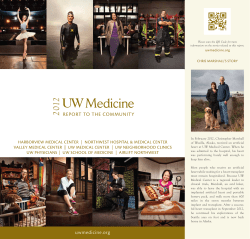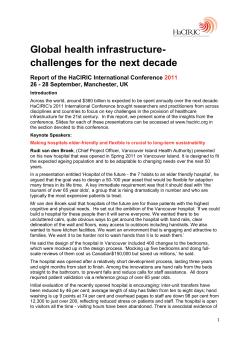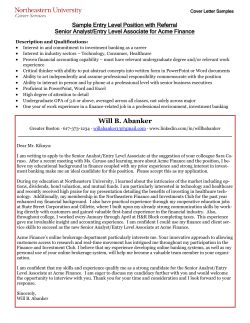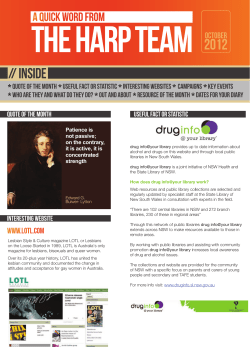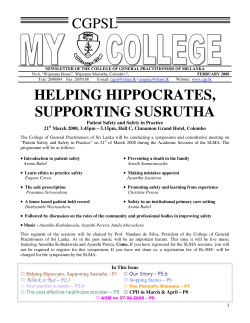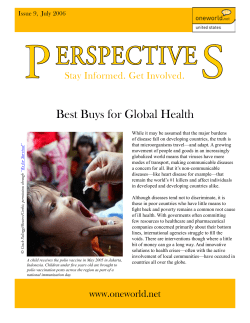
Document 7999
St. Vincent Healthcare Volume 7, Issue 3 March 2010 Medical Staff Officers: Gregory McDowell, MD, President Michael Bush, MD, President Elect Kevin McCrea, MD, Immediate Past President A NOTE FROM THE PRESIDENT OF THE MEDICAL STAFF Gregory McDowell, MD Department Chairs: Anesthesia—Zeferino Arroyo, DO Emergency Medicine – Jim Bentler, MD Family Med. -Vernon Johnson, MD Medicine – Charles McClave, MD OB/Gyn - Hal Forseth, MD Orthopedics- Curtis Settergren, MD Pathology – Paul Holley, MD Pediatrics – David Standish, MD Radiology – Kathleen Ryan, MD Surgery - Eric Dringman, MD Committee Chairs Bylaws—Grace Kim, MD Cancer – Martin Lucas, MD Credentials – Lionel Tapia, MD ICU – James McMeekin, MD Infection Control – Fred Kahn, MD MEC – Gregory McDowell, MD MSQIC – Jeff Johnson, MD OR - Benjamin Jagodzinski, MD Perinatal Care-Kathleen Stevens, MD P & T – Michael Hagan, MD Radiation Safety–John Hanson, MD Transfusion – Paul Holley, MD Trauma – Dennis Maier, MD Utilization Management— I would like to thank each of you for taking some of your valuable time to read these comments. I respect each of you. I admire your high academic achievements, professionalism and your focus on patients’ health enhancement as your professional priority. I share your commitment to your family, to the larger community about us and to your avocational interests. I applaud your passion for lifelong learning and I respect the sacrifice that you have made to pursue the practice of medicine. The long hours of work and the sleepless nights on call are realities that persist from our training days. The three foremost rules of residency are still valid today as they were then: If you see a chair, sit in it; if you see a bed sleep in it; if you see food, eat it. You are in a uniquely qualified position to comment on the strengths and weaknesses of our healthcare environment and to the challenges that confront both those providing and benefitting from the delivery of care today. You find understandable frustration in not being at the table and being forced to the sideline. The responsibilities that you bear and the decisions that you make have a great impact on human life and health each day. Paperwork requirements are enormous at times and the degree of multitasking that is required to manage your electronic lives sometimes stands in your way of effective patient care. Compliance and reporting requirements are growing annually. The ever present threat of litigation or fraud and abuse investigation exists. Your workforce seems to be small in the face of the growing demands and attrition is noted among your peers. The population is aging and growing and our patients are visiting more frequently with worsening health each year. The consumers of our healthcare product are in general heavier with more complex risk factors and more co-morbidity and are also older on average. Struggles with the growing inequity between physicians and facilities relative to reimbursement schedules exist as well as great frustration with working within an industry where the value of what you do is not determined by yourself but rather by an independent third party payer or payers. Heavy discounts on fee schedules are typical and the threat of these discounts growing in magnitude is real and likely imminent. The free market around you seems to be stifled and not at work. Few remember the ten years of training beyond college that is typical for physicians and the four years of additional cost that you bore for your education beyond your collegiate work. Further compounding your roles early on are the low earning potentials which you accepted during internship, residency and fellowships with the promise of better years to come. Most of us spent ten years after college without making any retirement contributions whatsoever to qualified benefit plans. Ten years out of college you are so far behind in your savings for retirement relative to your peers that there may be no opportunity to catch up subsequently. Nonetheless, each day you come to work to be a role model, an educator, a leader and to treat human suffering. You do no harm and take care of the underprivileged, those in great need and the sick and weary. You are highly respected by your patients and have always sought to be part of the solution and not part of a problem. You are committed to meaningful solutions and to attempting to leave our house of national healthcare in a good condition for those who follow rather than in a state of economic shambles. You have not abandoned your charitable or humanitarian agendas. You are a role model and beacon for the young individuals in training and allied health professionals as well as nurses that surround and support you. As you act in the best interest of your patient rather than in yourself, you define the word “professional.” Some thoughts on the current healthcare debate: At times all of us have felt that the current healthcare debate has been unsympathetic to the needs of the physicians and to patients for whom they provide care. Many physicians sense that the proposed healthcare reform agenda is frankly disrespectful to both physician and to the patients they serve. It has been stated that we provide some of the most inferior and expensive healthcare in the developed world. I find that contention objectionable on a number of levels although the financial data speaks for itself. I still think that in many regards we in the United States are world leaders in healthcare. Many international guests come to the United States for their education and training and the English literature is a central repository for the most credible peer-reviewed medical literature in the world. We are taking on some of the most complex challenges in regards to addressing the health of our consumers who have increasingly complex medical comorbidities. I ask Continued on Page 8 Come and celebrate with a lunch in your honor! Monday, March 29, 2010 Marillac Auditorium 11a.m.—1:30 p.m. Page 2 Page 3 New in Town…. Welcome!! Erich Garland, MD comes to us from Idaho Falls, ID and will be providing Locum coverage for SVH Hospitalist Neurologist program. Dr. Garland received his medical degree and completed his internship from Texas Tech University School of Medicine, Lubbock, TX. He completed a residency in Neurology at University of New Mexico Medical Center, Albuquerque, NM. Change of Status. The following providers have chosen to change their Medical Staff membership and / or privileges: Provider Name Department Request Bouldin, Anthony, MD Pediatrics / Neurology / Telemedicine OBGyn Voluntary resignation . Connor, G. Patrick, MD Durden, Angela, MD Pediatric / Neurology / Telemedicine Pathology Frewin, Curtis, MD Surgery / Ophthalmology Paul, Drake, MD Schmidt, Guy, MD Stears, Robert, MD Pediatrics / Critical Care Surgery, Orthopedic Radiology Swift, James, MD Thompson, Tracey, MD Pediatric / Critical Care Pediatrics / neonatology locum Davis, Bradley, MD Additional privilege—Gynecological Oncology Voluntary resignation Transfer from Provisional to Active – provisional monitoring complete Transfer from Provisional to Courtesy – provisional monitoring complete Voluntary resignation Voluntary Resignation Transfer from Provisional to Active – provisional monitoring complete Voluntary Resignation Voluntary resignation Department and Committee Happenings Committee Meeting Date Start Time End Time Requested location Anesthesia Department 3/22/2010 700 800 Board Room- 4 Allard DOCTORS DAY CELEBRATION 3/29/2010 1100 1330 MARILLAC AUDITORIUM Credentials Committee 4/5/2010 645 745 Board Room- 4 Allard Intensive Care Committee 4/8/2010 1200 1300 Board Room- 4 Allard Emergency Medicine Department 4/9/2010 700 830 Mansfield #7 Surgical M&M 4/12/2010 700 800 Mansfield Burns W Operating Room Committee 4/12/2010 700 800 Gallatin Room Medical Executive Committee 4/12/2010 1730 1930 Board Room- 4 Allard Medicine Department 4/13/2010 700 800 Mansfield 1 & 2 Trauma Committee 4/19/2010 645 830 Mansfield Burns W Orthopedics Department 4/19/2010 700 800 Mansfield 1 & 2 Pediatrics Department 4/21/2010 1230 1330 Mansfield Burns W Surgery Department 4/26/2010 700 800 Mansfield 1 & 2 Anesthesia Department 4/26/2010 700 800 Board Room- 4 Allard Podiatry Subsection 4/27/2010 700 800 Stillwater room Page 4 The SVH Medical Staff Bulletin Board Welcome daVinci! St Vincent Healthcare is pleased to announce the addition of da Vinci robotic assisted surgery. A philanthropic project of the St. Vincent Healthcare Foundation, the da Vinci has been delivered and is available for viewing in Surgical Services. The da Vinci’s sophisticated robotic technology allows surgeons to perform minimally invasive procedures with unrivaled precision. Training on the da Vinci is underway with the first procedures slated for mid to late April. Providers please remember to PRINT you name after your signatures! Thank you. National Healthcare Decisions Day 2010 Friday, April 16 SVHC Ethics Committee invites Providers (MD’s, PA’s and APRN’s) to a Provider Education Event Topic: Montana POLST (Provider Orders for Life Sustaining Treatment) Presenter: Jim Upchurch, MD (MT Board of Medical Examiners) 10:00 – 11:00 AM at MHEC, Burns Auditorium Dr. Upchurch will address the Montana POLST: how it was developed / adopted, how it is being implemented and how it interfaces with Comfort One, hospital DNR orders and Advance Directives. A blessing of da Vinci was held proceeding the open house on March 16. A community wide name the robot contest for grade school children will begin in late March. Physician Centricity Help Line For those pesky problems! 237-3900 If you don’t get an answer PLEASE LEAVE A MESSAGE with your call back number!! The phone is checked CONSTANTLY. Charlie or Dan WILL RETURN YOUR CALL!! NEW ISOLATION GOWN GO LIVE!! Starting March 22nd SVH will be transitioning to Non-Disposable Yellow Isolation Gowns at the Hospital. These gowns are used once and then placed in the dirty laundry bag which should be inside the patient’s room. Proper procedure includes gowning first and then gloves placed over the white cuff, covering the white cuff completely. When removing isolation gear, gloves are removed first followed by the gown and then mask if a mask was used. Hand hygiene is preformed before and after isolation. This new process has been instituted for two reasons, first during a pandemic event supplies are very limited and second during a natural disaster or pandemic event if our supply chain is cut off we have only three days worth of supplies on a routine basis at which point we would be unprotected. This new process will ensure the protection of our physicians and staff going forward. If you have any questions please feel free to contact Infection Prevention & Control at ex 3090. SCIP Corner In April there are some changes for SCIP (Surgical Care Improvement Project). Addition to the list of what is accepted as documentation of infection, and “Reasons to extend antibiotics” past the 24h (48h for Open Hearts) time period to have the antibiotics discontinued. New Reasons to Extend Antibiotics: Must be clearly documented as the reason 1. Erythromycin given postop for increasing gastric motility. 2. Hepatic encephalopathy 3. Pneumoscystis pneumonia in a pt with AIDS 4. Infection (Some new terms added to be considered as infection: Endometritis, free air in abd, necrosis, penetrating abdominal trauma, perforation of bowel, purulence/pus) 5. Current malignancy of the lower extremity having a joint revision 6. Previous surgery on a joint that is now having a joint replacement (i.e. ORIF to THA) 7. Culture was taken after incision, prior to abx (will be considered suspected infection, and will also exclude the abx prior to incision if clearly documented prior to surgery or during surgery as the reason to hold abx until after the culture is taken) HIPAA TIP To be HIPAA compliant make sure to log out of Centricity when you leave a workstation. Not logging out puts you at risk for the next person sitting at that workstation to access protected health information (PHI) under your password. Page 5 CMO Corner Notes My patient had an ADVERSE Event – What do I do? Of course the first priority upon discovery of an unanticipated outcome is to ensure the safety and care of the patient and any others who maybe at risk. Then what are the next steps? Ask someone to look up SVH Guidelines in the Apology and Disclosure Policy. Contact Risk Management or contact the Administrator on Call (pager 015) after hours. Then disclose, apologize and document. Mike Schweitzer, M.D., MBA Regional Chief Medical Officer Holy Rosary/St. Vincent Healthcare VP Medical Affairs, St. Vincent Healthcare According to a February 1, 2010, American Medical News article, 35 states currently have "apology laws" to prevent a physician's apology from being used as evidence in malpractice cases. The article describes how some medical liability insurers offer a premium discount to physicians who attend a seminar on disclosure and apology and some healthcare organizations have lowered costs associated with malpractice claims by adopting an "I'm sorry" policy. These policies require disclosure of facts related to adverse events, an appropriate physician apology, and financial compensation. (SVH has these policies.) The “I’m sorry” law adopted in 2005 in Montana rules that providing a “statement, affirmation, gesture, or conduct expressing apology, sympathy, commiseration, condolence, compassion or benevolence relating to the pain, suffering, or death of a person that is made to the person, the person’s family, or a friend of the person or the person’s family is inadmissible for any purpose in a civil action for medical malpractice”… It is recommended that you avoid using words such as “wrong”, error”, “mishap”, “incorrect”, “inadvertent”, “mistake”, and “accident”. What should be said is “I’m sorry that you (or a family member) had this complication.” In 2002, the University of Michigan Health System (UMHS) adopted a disclosure, apology and compensation policy, cutting litigation costs by $2 million a year and new claims by more than 40%. Rick Boothman, chief risk officer at the UMHS, is one of the early adopters and said the reason other doctors and hospitals have been slow to say "I'm sorry" is simple. "What holds us back is fear, and you can't quantify it," Boothman said. "Those fears are not the result of bad experiences -- they're the result of people who've never tried it." Dr. Gerald Hickson, a recognized expert on physician behavior, found that 24% of the patients he surveyed filed suit when they found that “the physician had failed to be completely honest with them about what happened, allowed them to believe things that were not true, or intentionally misled them.” The Institute of Medicine report in 1999 that popularized the statistic that 44,000 to 98,000 Americans die each year as a result of medical errors unleashed a variety of pressures to improve patient safety. Some medical liability insurers are open to the idea of doctors apologizing. COPIC Insurance Co., a medical liability carrier in Colorado, started openly communicating about medical errors in 2000 and reimburses patients for costs of up to $30,000. The American Medical Association ethical opinion states that when a doctor errs, "the physician is ethically required to inform the patient of all the facts necessary to ensure understanding of what has occurred" and that liability concerns should not impede disclosure. Our Risk Department coordinates an event determination or root cause analysis on near misses, adverse events, or unexpected outcomes. Our focus is fixing the process or system so it does not happen again. About 66% of the time, poor communication is a major contributor. The Department of Defense developed a class to train people to have better communication and perform better as a team. We have started training physicians and staff in that TeamSTEPPS (Strategies & Tools to Enhance Performance & Patient Safety) program. This is designed for health care professionals and strives to improve patient safety through an evidence-based teamwork system. It is designed around improving communicating and teamwork skills. TeamSTEPPS provides a source for ready-to-use tools to integrate teamwork principles into all areas of a health care system. It aims to produce highly effective medical teams that optimize the use of information, people, and resources to achieve the best clinical outcomes for patients. We are first targeting the high risk areas in our hospital. L&D training is nearly finished. The teams in OR, ED, and ICU are next. Page 6 Documentation Team says…. quested by the Recovery Audit Contractors to be reviewed for possible overpayment to the hospital. One of the main areas auditors across the country are looking at, is medical necessity for the patients’ admission. They are focusing a lot of their energy on patients admitted with symptom codes as their main diagnosis. THE DOCUMENTATION TEAM Mary Harmon –7788-378 Tena Pegar– 7788-521 Julie Skagen-7788-991 Den’Ette Boyer-7788-138 Henri Jenkins 7788-439 Dana Rutan-7788-762 Michael DeBar-7788-479 RAC and Medical Necessity Documentation Saint Vincent has received our first request for RAC audit charts. These are charts that have been re- Symptom code admits can include unspecified chest pain, abdominal pain, and back pain, they can also include altered mental status, shortness of breath and other symptoms. If at all possible, symptom code admits should be linked to a diagnosis such as, “Patient admitted with abdominal pain, possible gastroenteritis.” Please remember for CMS (Center for Medicare and Medicaid Services) and hospital coding purposes words such as: likely, possible, probable, suspicious for, are perfectly acceptable. Thorough documentation of your patients’ status, possible diagnoses and treatment plans is even more important now to show the medical necessity of your patients’ admission. The CDMP team will be glad to assist you as needed. This is great news for Montana! HealthShare MT (HSM) received today $5.76 million in Federal ARRA grant for expanding meaningful use health information exchange in MT. We previously received $1.4 million in combined state and federal startup money last fall. Loren Schrag, previously IT director for RMHN, is our new executive director. The state office will be in Billings. John Middleton joined the Board last fall after Mike Foster rotated off. John also is on the tech committee. I serve on the executive committee and also as Chair of Finance. HealthShare MT http://www.healthsharemontana.org/ is a grassroots statewide organization that we started about five years ago to create a statewide electronic health information exchange or Regional Health Information Organization (RHIO). We recently chose Doc Site to be our vendor for HIE. Elimination of “Self-Authorization” in Centricity We have found a solution for eliminating the “self-auth” requirement in Centricity that preserves our ability to protect patient privacy, while allowing easier access for physicians. The first part of the solution is new software that makes it easier to detect, track and report unauthorized access to patient records. The second part of the solution is an updated confidentiality agreement outlining accountability and responsibility associated with the privilege of accessing protected health information. We plan to disable the “self-auth” feature as soon as the majority of the medical staff has returned the updated signed agreement, with a target of two weeks from now. Anyone who does not return an updated agreement will still be required to “self-auth” according to the current process. Protecting the privacy and security of patient information has become critical in this age of electronic records and the Internet. At a minimum, physicians who are found to have failed to respect patient privacy will see their access privileges curtailed. Please contact the Medical Staff Office for a Self Authorization Removal form if you have not already received one via email. Please do not hesitate to contact me directly if you have questions, suggestions, or concerns. Sincerely, John Middleton, MD, FACS Chief Medical Information Officer St. Vincent Healthcare john.middleton@svh-mt.org (406) 237-3994 Office Page 7 Pharmacy Update Enoxaparin Dosing in Special Populations The Joint Commission National Patient Safety Goal 3E on improved anticoagulation management recommends individualizing anticoagulant dosage needs on a patient-specific basis. Recommendations for appropriate dosing of enoxaparin include dose adjustment for special populations, such as obese patients and those with renal failure. To meet this objective, pharmacists will be monitoring patients receiving enoxaparin to ensure appropriate dosage adjustments are being made. Pharmacists will contact providers if changes in dose or increased monitoring are recommended. They will also be available to assist with any dosing questions or needs. The following information summarizes recommendations in the literature for adjusting doses of enoxaparin based on renal function and obesity and provides monitoring guidelines. Enoxaparin Dosing in Renal Impairment • • Although no dose adjustment is recommended in patients with moderate (CrCl 30-50 mL/min.) and mild (CrCl 50-80 mL/min.) renal impairment, all such patients should be observed carefully for signs and symptoms of bleeding. The recommended prophylaxis and treatment dosage regimens for patients with severe renal impairment (CrCl < 30 mL/min.) are described below. Indication Dosage Regimen Prophylaxis in abdominal surgery 30 mg SC ONCE daily Prophylaxis in hip or knee surgery 30 mg SC ONCE daily Prophylaxis in medical patients during acute illness 30 mg SC ONCE daily Prophylaxis of ischemic complications of unstable angina & non-Q-wave myocardial infarction, when concurrently administered with warfarin Inpatient or Outpatient treatment of acute DVT with/without PE, when administered with warfarin 1 mg/kg SC ONCE daily • • 1 mg/kg SC ONCE daily Pharmacokinetic and clinical data on the use of enoxaparin in patients with renal impairment demonstrate that the half-life of anti -Xa activity is prolonged and increases with decreasing renal function, and that bleeding risk is increased in patients with renal impairment compared to those with normal renal function. It is recommended that anti-Xa monitoring be used in monitoring safety of enoxparin use in patients with severe renal impairment (CrCl < 30 mL/min.) It is recommended that the initial enoxaparin dose be reduced by 30-40% and further adjustments of 2040% are recommended as necessary. Enoxaparin Dosing in Obesity • • • • Patients of extreme body weight rarely have been included in clinical trials involving LMWHs. In controlled trials using weight-adjusted dosing regimens, the enoxaparin dose was based on patients’ actual body weight. Available evidence supports the use of TBW as the appropriate marker for LMWH dosing, and also cautions against underdosing in obese and morbidly obese patients. Some small studies show that in morbidly obese patients undergoing bariatric surgery, enoxaparin 40 mg SQ BID may be more effective in preventing VTE than lower doses. General Recommendations on the Use of LMWHs in Obese patients 1. 2. 3. 4. Capping the LMWH dosage is not routinely recommended. Avoid once-a-day dosing schedules in obese patients requiring treatment for DVT or PE Anti-Xa monitoring is recommended for patients with a TBW of <45 kg or >150 kg. Increasing the prophylactic LMWH dosage by 30% may be appropriate in morbidly obese patients or consider Lovenox 0.5 mg/ kg based on TBW ONCE daily for prophylaxis. Measure anti-Xa level within 3-7 days of therapy initiation. 5. Anti-Xa Monitoring Recommendations – Enoxaparin • • • • Desired therapeutic range (Prophylaxis) – 0.2-0.4 IU/mL Desired therapeutic range (Treatment) – 0.5-1.2 IU/mL It is recommended that the sample for testing be collected 4 hours after the 2nd or 3rd SC dose. Maximum peak anti-Xa activity occurs 3-5 hours after SC injection. Recommended for high risk groups. For more information on enoxaparin dosing, please contact Stephanie Longin, PharmD (237-8119) or Brett Stubson, RPh, MS (237-8112). References Hirsch J, et. al. Parenteral Anticoagulants. In: American College of Chest Physicians Evidence-Based Clinical Practice Guidelines (8th edition). Chest Supplement 2008;133: 141S-159S. Sanofi-Aventis. Lovenox® package insert. Bridgewater, NJ:2007 October. Page 8 Page 9 Presidential notes…continued from page 1 you today who is more dissatisfied, the average patient with his physician or the average citizen with his member of congress? I would like to see healthcare reform come full circle to address first and foremost the concerns of the frontline providers in medicine and their patients’ best interests. Healthcare at its simplest level is physicians and other healthcare providers taking care of patients. In the current debate we are overwhelmed with the big business of medicine and have lost some focus on what medicine has historically been and how its core relationships are best defined between provider and consumer. I find several areas of overwhelming concern with the current reform agenda. Clearly, the agenda is cumbersome. Two thousand pages of new amendments and resolutions are hard to integrate into our already busy lives. Our system needs to be simplified and is already excessive in its complexity. I find it very objectionable that there is a current threat to expand the fraud and abuse investigations through the use of plain-clothed Department of Justice operatives that impersonate patients in your offices. Are you thinking about this now and ready for this intrusion and entrapment? I’ll bet you are as resistant to this concept as I am. This past week I was at a meeting of 104 Board of Counselors for the American Academy of Orthopaedic Surgeons and I posed the question as to whether or not there was any support from the Board members, who are all physicians, for implementing this fraud and abuse strategy. There was not a single member assembled that was in support of this proposal that President Obama states has Republican support. The current reform plan calls for more taxation across the board, and for the incomes of families with high earning potential as well as for a reduction in reimbursement to physicians. Additional penalties of course are proposed to entitlement reimbursements for failure to comply with the growing number of measures of compliance initiatives. As an example of an intrusive and sometimes less than valuable compliance initiative that has been adopted, I will reference the “Marking Your Surgical Site” initiative. While marking one’s surgical site makes sense in the case of a lateralizing or hidden lesion, it strikes me as absurd when the policy is applied to an obvious lesion or a midline structure. Just today I took an additional ten minutes out of an already full schedule to run to Surgery Plus from my office to remark a midline lumbar incision that had been previously marked 48 hours earlier after the mark was washed off. Apparently your legislators have in the past been convinced that a fellowship trained spine surgeon does not know where the lumbar spine is and needs to mark the midline lumbar region to assure the safety of the patient. These imposed initiatives are frankly ridiculous but are we to not comply we simply cannot do our work in federally supported institutions. The documentation required to address compliance has grown in scope and now provide additional frustration and loss of efficiency for us in our systems. The insistence on more use of electronic media and automated health information systems will likely move us in a direction that we need to be evolving; however, the contention that information technological changes will reduce medical error rates and will reduce costs has lacked evidence-based support. Some of these systems have a net effect of reduction in efficiency and increasing our cost basis. The mere purchasing of electronic health record software systems, not to mention the hardware support and the required hiring of multiple individuals with IT backgrounds to support those systems will be a significant expenditure. Many legislators seem not to recognize this. One wonders whether providers can fully comply with the 26 meaningful use criteria that will be necessary to receive the 44-thousand dollars of stimulus money. Additionally, healthcare reform seems to contain no meaningful support for tort reform. There does not seem to be anything in healthcare reform that would reduce the large class action suits, some of which are supported by the federal government against drug manufactures or device manufacturers. Some of these settlements are exorbitant. I would give you as examples Eli Lilly’s settlement, the Pfizer settlement the DePuy AcroMed’s settlement on pedicle screws. Were meaningful reform to exist in the case of personal injuries, such as has been enacted in Canada, we would likely spend a lot less money litigating and supporting the health care needs of those with minimal injuries following low speed vehicular accidents. Additionally, it would be very helpful to have substantial reform within the workmen’s compensation system to allow some reasonable limits to be set on workplace injuries that simply are aggravations of underlying degenerative conditions. A lot of money is wasted in each of these areas in healthcare and certainly a lot of time. What would be very useful in healthcare reform would be to develop true measures assessing the value of the product that is received by the consumer. By that I mean what is the quality of the product and the outcome that they benefit from as a function of the cost of that benefit? We here at St. Vincent Healthcare acknowledge that being able to assess and track value is one of our highest priorities in the coming years. We need a great deal of professional input from our physicians to help us understand what are our true measures of success and a good deal of transparency and compliance from all of us and from our facility to assess the cost piece. Without this, free market forces will not be able to overcome the current confused and complex arm’s length relationship that exists between the consumer and the provider. What can we do? I know each and every one of us wants to be part of the solution and are committed to weighing in on what is of vital importance to us. We will use our position of leadership and our central insights to slowly influence the swing of the pendulum. We must use our powerful combined voices to create a symphony and to avoid a singular agenda. We will insist on market forces defining our boundaries through consumer choice and preference and we will support transparency in our quality and reporting of price. We will not continue to passively accept unreasonable escalations in workplace demands without responding to the challenge. We will not leave our house of national healthcare in economic shambles. Enhancements in preventative care and wellness and promotion of aggressive measures supporting healthy nutrition, regular physical exercise programs in the schools and fast food labeling reform will probably be very helpful. Our aggressive efforts to reduce the epidemic of obesity in this country will see great benefits downstream in addressing our problems with diabetes, hypertension, vascular diseases and diseases that are the result of obesity including degenerative conditions of the spine and of the extremities. Unless we address this root cause of many of our health comorbidities the downstream disease prevalence will continue to spiral out of control. It is already unmanageable in my opinion and many of us feel like we are swimming upstream against a very strong current that eventually will wash us away. I sense that we may need to support initiatives that decrease the use of costly prescription drugs. Reasonable limits on endof-life care are controversial but most of us support hospice and home healthcare models being expanded. I think it would be helpful to consider placing a reasonable cap on the markups that facilities charge for devices and drugs. Meaningful reform of workmen’s comp, medical liability and insurance of the Food and Drug Administration policies regarding new devices may need to be considered, in part to avoid stifling the free market. We need to encourage rather than discourage physicians from being central to the process of focusing our healthcare reform agendas. Who is more familiar with the patients’ need and the best interest of the patients, their physicians or others who are at arm’s length from the process and seek to influence it from outside? We need to reaffirm the high position of esteem that we have for physicians and treat the profession again with deserving respect. This will mean less micromanagement and compliance initiatives, not more. If we improve our workplace performance internally we will regain and enhance our professional satisfaction and retain physicians in the workforce. Thank you for taking the time to read these comments and opinions which are an expression of my own thoughts and not necessarily of those around me or of the institution within which I work.
© Copyright 2025


